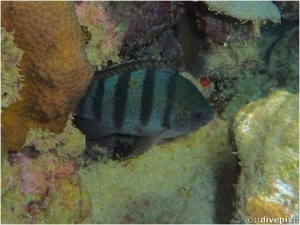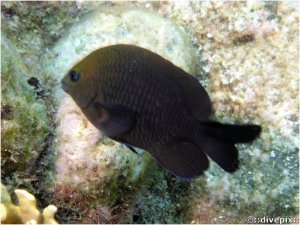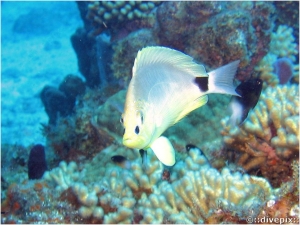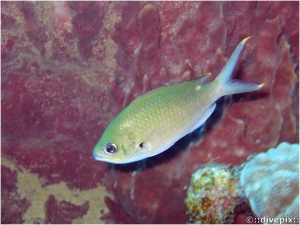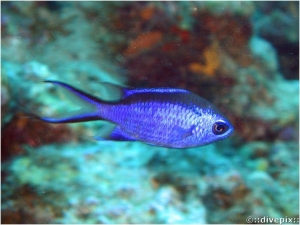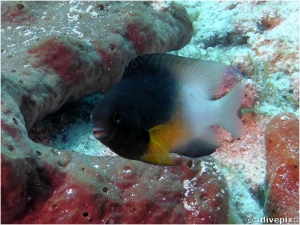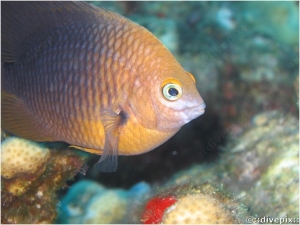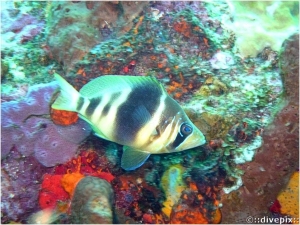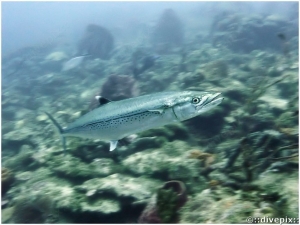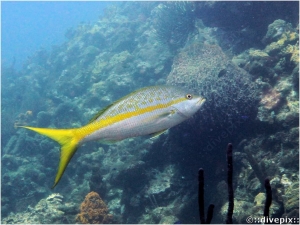




Eric H. Biass
Wednesday, 28 November 2012 18:07
Sergeant Major
| Aspect: | All Damselfishes have similar outlines, but with more or less deeply pronounced "chin-pectoral" area and dorsal fin tips of various shape. |
| Population: | Abundant. |
| Notable feature: | Silver body with five dark vertical bars, the last one straight on the root of the tail fin. Yellow patch on dorsal area spreads between the bars but fades with age. Most importantly, male's silvery area turns dull grey during courtship and while, as seen here, protecting and ventilating eggs layed straight against against rock surfaces. |
| Environment: | Rocky areas, coral boulders. |
| Behaviour: | Can be approached, curious, but constantly moves (especially when guarding eggs), hence difficult to photograph. |
Published in
Damselfishes
Tagged under
Wednesday, 28 November 2012 17:44
Longfin Damselfish
| Aspect: | All Damselfishes have similar outlines, but with more or less deeply pronounced "chin-pectoral" area and dorsal fin tips of various shapes. |
| Population: | Abundant. |
| Notable feature: |
Stegates diencaeus distinguishes itself from its brown counterparts in having round tipped dorsal and anal fins that extend well beyond the root of the tail. It also has a bluefringe around its anal fin. Juvenile is yellow with purple/blue dots, then striped forehead, from where it darkens with age, losing its dorsal black spot in the process. |
| Environment: | Rocky areas, coral boulders. |
| Behaviour: | Can be approached (except juvenile), curious, but constantly moves. |
Published in
Damselfishes
Tagged under
Tuesday, 27 November 2012 19:19
Butter Hamlet
| Aspect: | Somewhat flattened triangular outline with upper corner in the centre of the dorsal spine, silver body with pale yellow to yellow lower half body with distinctive black blotch on tail base and in the nasal opening region just ahead of the eyes. |
| Population: | Somewhat scarcer than barred Hamlet. |
| Notable feature: | Vertical blue fluo spots from nasal openings to gill area. |
| Environment: | Close to bottom, around rocks and coral boulders that offer quick shelter. |
| Behaviour: | Shy. |
Published in
Hamlets
Tagged under
Tuesday, 27 November 2012 18:56
Brown Chromis
| Aspect: | Light brown oval body with deep-cut tail fin. Massive grey-brown body. |
| Population: | Abundant. |
| Notable feature: | Except juveniles, features gilt-tipped dorsal and tail fins, golden spot at base of tail fin, dark spot at root of pectoral fin. As similar Blue Chromis (q.v.) mouth line distinctively raises from sides to nasal opening. |
| Environment: | Shallow waters, often in groups around rocks. |
| Behaviour: | Can be approached, but constantly moves, and photographing diver often needs to be aware of urchins around which it often swims for protection. |
Published in
Chromis
Tagged under
Tuesday, 27 November 2012 17:23
Blue Chromis
| Aspect: | Silver blue oval body with deep V- cut tail fin. Darker dorsal area stretches to upper part of tail fin, which the lower fin replicates. |
| Population: | Abundant. |
| Notable feature: | Mouth line distinctively raises from sides to snout . |
| Environment: | Shallow waters, often in groups around rocks. |
| Behaviour: | Can be approached, but constantly moves, and photographing diver often needs to be aware of urchins around which it often swims for protection. |
Published in
Chromis
Tagged under
Monday, 26 November 2012 22:59
Bicolour Damselfish
| Aspect: | All Damselfishes have similar outlines, but with more or less deeply pronounced "chin-pectoral" area and dorsal fin tips of various shape. |
| Population: | Common. |
| Notable feature: | The distribution between the front dark area and yellow patch over the white after part can vary from vertical to almost horizontal. The yellow patch would tend to fade with age. |
| Environment: | Rocky areas, coral boulders. |
| Behaviour: | Can be approached, curious, but constantly moves. |
Published in
Damselfishes
Tagged under
Monday, 26 November 2012 19:37
Cocoa Damselfish
| Aspect: | All Damselfishes have similar outlines, but with more or less deeply pronounced "chin-pectoral" area and dorsal fin tips of various shape. |
| Population: | Not abundant (or probably more correctly remains hidden). |
| Notable feature: | Very difficult to distinguish from other brown-coloured damselfishes, but the Cocoa Damselfish appears to feature a more "straight pointed" nose particularly when compared with the Beaugregory. As exemplified by this specimen, does not necessarily carry a very pronounced darker stain on its upper tail root (very faint in this ocurrence). A number of descriptions mention a slightly more orangy belly. |
| Environment: | Rocky areas, coral boulders. |
| Behaviour: | Can be approached when spotted, curious, but constantly moves. |
Published in
Damselfishes
Tagged under
Monday, 26 November 2012 19:14
Barred Hamlet
| Aspect: | Somewhat triangular fish with summet in dorsal spine, cream body with six main vertical bars, the first across the eyes, followed by a lighter one, the darker third very wide is mid-body, followed by another three with the last on tail base. |
| Population: | Common. |
| Notable feature: | Typical almond shaped eyes a la grouper (q.v.), fluo blue lines around eyes and gills, blue fluo spots in nasal opening area. Is much smaller than suggested by photos. |
| Environment: | Close to bottom around rocks and coral boulders offering quick shelter. |
| Behaviour: | Shy. |
Published in
Hamlets
Tagged under
Saturday, 24 November 2012 20:44
Cero
| Aspect: | Sleek and elegant silver body, with matching elongated head. Serrated spine and rear "keel" aft dorsal and anal fins |
| Population: | Abundant. |
| Notable feature: | Long line of dense dark dots, accompanied by other randomly scattered dots, runs from gills along mid-body, and fades towards deep-V and pointed tail. Dorsal fin is dark with white tip. Displays nice array of needle teeth when opens mouth. |
| Environment: | Usually found in open waters, solitary or in pairs |
| Behaviour: | Ignores divers. |
Published in
Mackerels
Tagged under
Saturday, 24 November 2012 20:12
Yellowtail Snapper
| Aspect: | Distinctive streamlined silver body crossed from eye to tail by a bright expanding stripe that eventually spreads its golden hue over the entire caudal fin surface. |
| Population: | Abundant, solitary or in schools. |
| Notable feature: | Rarely deployed, the dorsal fin is also bright yellow; upper half of silver boddy generally studded with yellow dots. |
| Environment: | Often seen rubbing shoulders with similarly-sized Goatfishes (q.v.) in search of food on sandy bottom. |
| Behaviour: | Like Goatfishes, will fearlessly approch a diver's hand digging the sand. |
Published in
Snappers
Tagged under



